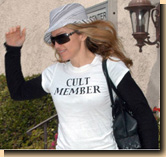Cabala's Pagan Origins
 Following the division of Israel and the Assyrian captivity
of the northern tribes, the southern kingdom of Judah adopted the pagan
traditions of the heathen nation of ancient Babylon. These traditions, with
their associated rituals which included human sacrifice, provoked God to judge
the southern kingdom, which judgment the prophet Jeremiah forewarned the Jews
for a period of forty years, to no avail.
Following the division of Israel and the Assyrian captivity
of the northern tribes, the southern kingdom of Judah adopted the pagan
traditions of the heathen nation of ancient Babylon. These traditions, with
their associated rituals which included human sacrifice, provoked God to judge
the southern kingdom, which judgment the prophet Jeremiah forewarned the Jews
for a period of forty years, to no avail.
The Babylonians destroyed Jerusalem in three
stages, from 605 to 586 B.C., in which year the Temple of Solomon was demolished
and the remaining Jews were carried into captivity. During the Babylonian
captivity, the prophet Ezekiel continued to reprove Judah for its apostasy from
the God of Israel and their love affair with Babylon. Note, in the following
passage, the Jews’ admiration for the images of rich, brightly attired
Babylonian princes, which evoke visual images of the elegant processions of the
princes of the Roman Catholic Church attired in their rich and colorful
vestments:
“...[Jerusalem]
increased her whoredoms: for when she saw men pourtrayed upon the wall, the
images of the Chaldeans pourtrayed with vermilion, Girded with girdles upon
their loins, exceeding in dyed attire upon their heads, all of them princes to
look to, after the manner of the Babylonians of Chaldea, the land of their
nativity: And as soon as she saw them with her eyes, she doted upon them, and
sent messengers unto them into Chaldea. And the Babylonians came to her into the
bed of love, and they defiled her with their whoredom, and she was polluted with
them, and her mind was alienated from them. So she discovered her whoredoms, and
discovered her nakedness: then my mind was alienated from her...”
(Ezek.23:14-18)
Moreover, as Matthew
Henry noted in his commentary on this passage, the kingdom of Judah patterned
its own worship after the pomp and pageantry of the Babylonians with whom they
had become enamored:
“Thus she increased her
whoredoms; she fell in love, fell in league, with the Chaldeans. Hezekiah
himself was faulty this way when he was proud of the court which the king of
Babylon made to him and complimented his ambassadors with the sight of all his
treasures, Isa. 39:2. And the humour increased (v. 14); she doted upon the
pictures of the Babylonian captains (v. 15, 16), joined in alliance with that
kingdom, invited them to come and settle in Jerusalem, that they might refine
the genius of the Jewish nation and make it more polite; nay, they sent for
patterns of their images, altars, and temples, and made use of them in their
worship. Thus was she polluted with her whoredoms (v. 17), and thereby she
discovered her own whoredom (v. 18), her own strong inclination to idolatry.”
According to two
authoritative sources, H.P. Blavatsky and the
Jewish Encyclopedia, the Jews also acquired from the Chaldeans their
doctrines of Eastern mysticism. These were later developed into a written
compendium of esoteric literature known as the Jewish Qabbalah or Kabalah, and
in the Middle Ages as the Latin Cabala.
“Kabalah (Heb.) The
hidden wisdom of the Hebrew Rabbis of the middle ages derived from the older
secret doctrines concerning divine things and cosmogony, which were combined
into a theology after the time of the captivity of the Jews in Babylon. All the
works that fall under the esoteric category are termed Kabalistic.” (Blavatsky,
Theosophical Glossary, p. 168)
“The Pythagorean idea of
the creative powers of numbers and letters, upon which the ‘Sefer Yetzirah’ is
founded, and which was known in tannaitic times…is here proved to be an old
cabalistic conception. In fact, the belief in the magic power of the letters of
the Tetragrammaton and other names of the Deity…seems to have originated in
Chaldea (see Lenormant, ‘Chaldean Magic,’ pp. 29, 43). Whatever, then, the
theurgic Cabala was …, the very fact that Abraham, and not a Talmudical hero
like Akiba, is introduced in the ‘Sefer Yetzirah,’ at the close, as possessor of
the Wisdom of the Alphabet, indicates an old tradition, if not the antiquity
of the book itself…
“The whole dualistic
system of good and of evil powers, which goes back to Zoroastrianism and
ultimately to old Chaldea, can be traced through Gnosticism; having
influenced the cosmology of the ancient Cabala before it reached the medieval
one…
“The gradual
condensation of a primal substance into visible matter, a fundamental doctrine
of the Cabala, … is the ancient Semitic conception of the ‘primal ocean,’ known
to the Babylonians as ‘Apsu’ (compare Jastrow, ‘Religion of Babylonia’),
and called by the Gnostics βύθος = (Anz,
‘Die Frage nach dem Ursprung des Gnostizismus,’ p. 98).”
The Chaldean religious
tradition that was embraced by apostate Jews during their captivity in Babylon
was delivered to subsequent generations by word of mouth. According to
Blavatsky, these disseminators of the Chaldean tradition in the few centuries
before Christ were known as Tanaim:
“Kabalist. From Q B L H,
Kabala, an unwritten or oral tradition. The kabalist is a student of ‘secret
science’, one who interprets the hidden meaning of the Scriptures with the help
of the symbolical Kabala… The Tanaim were the first kabalists among the Jews;
they appeared at Jerusalem about the beginning of the third century before the
Christian era… This secret doctrine is identical with the Persian wisdom, or
‘magic’.” (Ibid. p.167)
The dictionary defines
the Medieval Latin cabala as derived from the Hebrew word “qabb lâ”
which means “received doctrine, tradition, from qibb
lâ”
which means “received doctrine, tradition, from qibb l,
to receive.” According to the Jewish Encyclopedia, Cabalists claimed to have
received these oral traditions, not from ancient Chaldeans, but from the
Patriarchs and Prophets “by the power of the Holy Spirit.”
l,
to receive.” According to the Jewish Encyclopedia, Cabalists claimed to have
received these oral traditions, not from ancient Chaldeans, but from the
Patriarchs and Prophets “by the power of the Holy Spirit.”
“Cabala comprised
originally the entire traditional lore, in contradistinction to the written law
(Torah), and therefore included the prophetic and hagiographic books of the
Bible, which were supposed to have been ‘received’ by the power of the Holy
Spirit rather than as writings from God’s hand... Each ‘received’ doctrine
was claimed as tradition from the Fathers...to be traced back to the Prophets or
to Moses on Sinai... The chief characteristic of the Cabala is that, unlike the
Scriptures, it was entrusted only to the few elect ones;…’”
Because of its
heretical nature, the Cabala was not generally promulgated among the Jews
but remained the “secret doctrine” of “elect” Jews. That is to say, certain Jews
who were deemed worthy could comprehend hidden teachings in the written Torah
and, through mystical techniques, make direct contact with “God.” Among these
practices are rapid recitation of the “Holy Name of God” (YHVH, or
Tetragrammaton), meditation on the 11 Sephiroth of the Tree of Life which are
believed to be emanations of God, learning to use the 22 letters of the Hebrew
alphabet as force-carrying energy patterns which serve as the building blocks of
the cosmos, and, finally, transcending the space/time limitations of the
physical world to realize one’s “inner divinity.” This “secret doctrine” has
been preserved throughout the ages to the present time by a spiritual
brotherhood who progress individually to various stages of enlightenment and
proficiency in the hidden wisdom—from “elect” to “adepts” to “wise men” to
“adepts in grace”:
“Cabala... The specific
term for the esoteric or mystic doctrine concerning God and the universe,
asserted to have come down as a revelation to elect saints from a remote past,
and preserved only by a privileged few. At first consisting only of empirical
lore, it assumed, under the influence of Neoplatonic and Neopythagorean
philosophy, a speculative character. In the geonic period it is connected with a
Mishnah-like text-book, the ‘Sefer Yetzirah,’ and forms the object of the
systematic study of the elect, called ‘mekubbalim’ or ‘ba’ale ha-Kabbalah’
(possessors of, or adepts in, the Cabala). These receive afterward the name of
‘maskilim’ (the wise), after Dan. xii. 10; and because the Cabala is called (‘Hokmah
nistarah’ = the hidden wisdom), the initials of which receive the meaning
‘adepts in grace’ (Eccl. ix. 11, Hebr.).” (Ibid.)
SOURCE of excerpt
"Kabbalism is a system of Jewish mysticism and magic and is the foundational element in
modern witchcraft. Virtually all of the great witches and sorcerers of this century were Kabbalists."
-William J. Schnoebelen, The Dark Side of Freemasonry
Kabbalah
Exposed |
Kabbalah Refuted |
Kabbalah's Dark Secrets
Truth About the Madonna Cult |
Inside Hollywood's Hottest Cult -Kabbalah
The Crazy World of Kabbalah |
The Deadly Fruit of Kabbalah
|
Mormonism and the Kabbalah

 Following the division of Israel and the Assyrian captivity
of the northern tribes, the southern kingdom of Judah adopted the pagan
traditions of the heathen nation of ancient Babylon. These traditions, with
their associated rituals which included human sacrifice, provoked God to judge
the southern kingdom, which judgment the prophet Jeremiah forewarned the Jews
for a period of forty years, to no avail.
Following the division of Israel and the Assyrian captivity
of the northern tribes, the southern kingdom of Judah adopted the pagan
traditions of the heathen nation of ancient Babylon. These traditions, with
their associated rituals which included human sacrifice, provoked God to judge
the southern kingdom, which judgment the prophet Jeremiah forewarned the Jews
for a period of forty years, to no avail. 